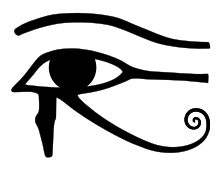Heqet
Heqet (Egyptian ḥqt, also ḥqtyt "Heqtit") is an Egyptian goddess of fertility, identified with Hathor, represented in the form of a frog. [1] To the Egyptians, the frog was an ancient symbol of fertility, related to the annual flooding of the Nile. Heqet was originally the female counterpart of Khnum, or the wife of Khnum by whom she became the mother of Her-ur.[2] It has been proposed that her name is the origin of the name of Hecate, the Greek goddess of witchcraft.
| Heqet | ||||||||
|---|---|---|---|---|---|---|---|---|
 Anthropomorphic depiction of Heqet in the temple relief of Ramesses II in Abydos | ||||||||
| Name in hieroglyphs | ||||||||
| Animals | Frog | |||||||
| Gender | Female | |||||||
| Consort | Khnum | |||||||
| Offspring | Horus | |||||||
| Part of a series on |
| Ancient Egyptian religion |
|---|
 |
|
Beliefs |
|
Practices
|
|
Deities (list) |
|
Locations |
|
Symbols and objects
|
|
Related religions
|
|
|
Name
The name is written as ḥqt with the determinative "frog" (I7).[3] The phonetic spelling may use the biliteral ḥq hieroglyph (S38) in place of uniliteral ḥ (V28). The alternative form ḥqtyt adds an explicit feminine ending, used alongside the "egg" determinative (H8) to emphasize the deity's femininity.[2] The Middle Egyptian pronunciation of the name may have been close to /ħaˈqaːtat/, which has been proposed (among other possibilities) as the origin of the name of Greek Hecate (Ἑκάτη).[4]
Worship
The beginning of her cult dates to the early dynastic period at least. Her name was part of the names of some high-born Second Dynasty individuals buried at Helwan and was mentioned on a stela of Wepemnofret and in the Pyramid Texts. Early frog statuettes are often thought to be depictions of her.[5]
Heqet was considered the wife of Khnum, who formed the bodies of new children on his potter's wheel.[6]
In the Osiris myth, it was Heqet who breathed life into the new body of Horus at birth, as she was a goddess of the last moments of birth. As the birth of Horus became more intimately associated with the resurrection of Osiris, so Heqet's role became one more closely associated with resurrection. Eventually, this association led to her amulets gaining the phrase I am the resurrection in the Christian era along with cross and lamb symbolism.[7]
A temple dedicated to Horus and Heqet dating to the Ptolemaic Period was found at Qus.[8][9]
As a fertility goddess, associated explicitly with the last stages of the flooding of the Nile, and so with the germination of corn, she became associated with the final stages of childbirth. This association, which appears to have arisen during the Middle Kingdom, gained her the title She who hastens the birth (cf. the role of Heqet in the story of The Birth of the Royal Children from the Westcar Papyrus[10]). Some say that—even though no ancient Egyptian term for "midwife" is known for certain—midwives often called themselves the Servants of Heqet, and that her priestesses were trained in midwifery.[11] Women often wore amulets of her during childbirth, which depicted Heqet as a frog, sitting in a lotus.
Gallery
 The god Khnum, accompanied by Heqet, moulds Ihy in a relief from the mammisi (birth temple) at Dendera Temple complex
The god Khnum, accompanied by Heqet, moulds Ihy in a relief from the mammisi (birth temple) at Dendera Temple complex- Early Dynastic Period (c. 3000 BC) frog statuette (Cleveland Museum of Art)
References
- Armour, Robert A. (2001). Gods and Myths of Ancient Egypt. American University in Cairo Press. p. 116.
- "The frog appears to have been worshipped in primitive times as the symbol of generation, birth and fertility in general; the Frog-goddess Ḥeqet or Ḥeqtit was identified with Hathor, and was originally the female counterpart of Khnum, by whom she became the mother of Heru-ur. The great antiquity of the cult of the frog is proved by the fact that each of the four primeval gods, Ḥeḥ, Kek, Nāu, and Amen is depicted with the head of a frog, while his female counterpart has the head of a serpent. The cult of the frog is one of the oldest in Egypt, and the Frog-god and the Frog-goddess were believed to have played very prominent parts in the creation of the world." E. A. Wallis Budge, The Gods of the Egyptians: Or, Studies in Egyptian Mythology vol. 2 (1904), p. 378.
- Erman, Johann Peter Adolf; Grapow, Hermann, eds. (1971). Wörterbuch der aegyptischen Sprache im Auftrage der deutschen Akademien. Berlin: Akademie-Verlag GmbH. p. 169.10.
- McKechnie, Paul, and Philippe Guillaume. Ptolemy II Philadelphus and His World. Leiden: Brill, 2008. page 133.
- Wilkinson, Toby A. H. (1999). Early Dynastic Egypt. Routledge. p. 286.
- Wilkinson, Richard H. (2003). The Complete Gods and Goddesses of Ancient Egypt. Thames & Hudson. p. 229
- Shier, Louise A. (1972). The Frog on Lamps from Karanis. Medieval and Middle Eastern Studies. Brill. p. 357. ISBN 9004034064.
- Porter, Bertha and Moss, Rosalind. Topographical Bibliography of Ancient Egyptian Hieroglyphic Texts, Reliefs and Paintings, V Upper Egypt: Sites (Volume 5). Griffith Institute. 2004.
- Wilkinson, Richard H., The Complete Temples of Ancient Egypt, Thames and Hudson, 2000, pp 152, ISBN 0-500-05100-3
- Lichtheim, M. (1973). Ancient Egyptian Literature. 1. p. 220.
- Franklin, Rosalind (2005). Baby Lore: Superstitions and Old Wives Tales from the World Over Related to Pregnancy, Birth and Babycare. Diggory Press. p. 86.
External links
